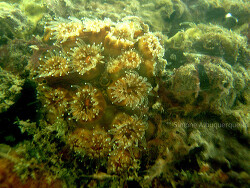Info
Colonies of stony coral form small, encrusting groups of polyps that develop from a common basal coenosteum.
Occasionally, corallites sprout from the lower theca of a parent corallite, and even intratentacular budding may occur.
Corallites are often close together, with thecae of adjacent corallites sometimes fused together.
The largest corallite known is 15.9 mm in diameter and 1 cm high.
Color:
All corallites have a distinct light brown coloration within the calyx plate and on the upper theca, the lower theca and coenosteum are white.
The color of living corallites is reddish-brown.
Habitat:
On the underside of rocks, ledges, and cave ceilings to a depth of 30 metersr, where they attach and encrust.
Sponges, algae and other organisms often overgrow the surrounding substrate so that only the individual polyps of the coral are visible.
Synonym:
Phyllangia fuegoensis Squires, 1963
Subspecies: Phyllangia americana americana Milne Edwards & Haime, 1849
Subspecies: Phyllangia americana mouchezii (Lacaze-Duthiers, 1897)
Occasionally, corallites sprout from the lower theca of a parent corallite, and even intratentacular budding may occur.
Corallites are often close together, with thecae of adjacent corallites sometimes fused together.
The largest corallite known is 15.9 mm in diameter and 1 cm high.
Color:
All corallites have a distinct light brown coloration within the calyx plate and on the upper theca, the lower theca and coenosteum are white.
The color of living corallites is reddish-brown.
Habitat:
On the underside of rocks, ledges, and cave ceilings to a depth of 30 metersr, where they attach and encrust.
Sponges, algae and other organisms often overgrow the surrounding substrate so that only the individual polyps of the coral are visible.
Synonym:
Phyllangia fuegoensis Squires, 1963
Subspecies: Phyllangia americana americana Milne Edwards & Haime, 1849
Subspecies: Phyllangia americana mouchezii (Lacaze-Duthiers, 1897)







 Pauline Walsh Jacobson, USA
Pauline Walsh Jacobson, USA




